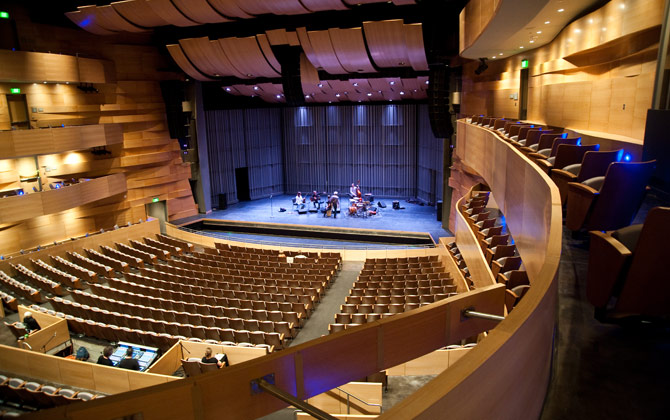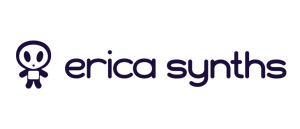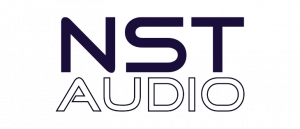After a decade of planning and execution, the world class Valley Performing Arts Center (VPAC) at California State University, Northridge opened its doors in January. The goal of the $125 million PAC project was to weave mechanical, electrical, theatrical, acoustical, audio visual and structural systems into a cost effective, energy efficient and sustainable design to provide a superior acoustical environment for audience and performers alike – including music, dance and theatre – and to serve as an architectural and cultural landmark for the entire San Fernando Valley.
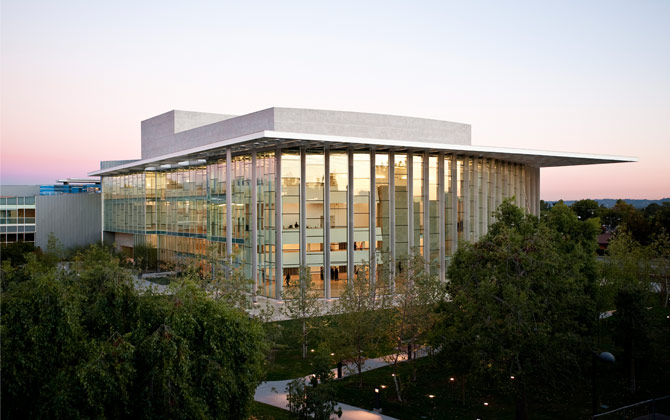
Above: The Gorgeous Valley Performing Arts Centre.
The 166,000 square foot PAC – the first and only major Los Angeles PAC facility north of downtown – encompasses a 1,700-seat, multi-purpose concert hall designed to support orchestra, opera, Broadway, film and dance, a 178-seat black box theatre, backstage support, classrooms, a 230-seat lecture room, a rehearsal and events space, and a new broadcast facility for KCSN public radio. Paying fervent detail to acoustics and audio design, the team of McKay Conant Hoover (MCH) was hired to oversee the acoustical and A/V media design, with Pro Sound & Video, North Hollywood office, handling the A/V integration. One of the challenges for MCH was that, over the course of the 10-year design and construction process, significant technology that had been specified had become antiquated and/or discontinued – including the digital console slated for the core of the audio system.
“Once that happened, we immediately started looking at all the players in the market,” offered AV Senior Consultant Kyle Ridenour of McKay Conant Hoover. “We had definitely been down this road many times before and looked at a lot of things, including where various products were in their life cycle, their redundancies and capacities, and how well they were being accepted on the front edge of performance technology, because that usually ends up trickling back down into the installed arena. We were looking for a product that was going to have relevance well into the future. Also, we needed to be able to accommodate the very large input/output field associated with the many facility infrastructure panels without having a huge, inconvenient, and perhaps eventually noisy analog patch field. The I/O field of the SD7, and its ability to connect an enormous amount of inputs and outputs using the frames, was something that was very attractive to us—and there are not that many animals out there that can do that amount of work. We had also seen the SD7 emerging at the high levels of touring technology with some of the really big bands like U2 and such, and that was a plus. Not to mention, the pedigree of the SD7, coming from the D5 family, was something that we looked at, too. So, it was all of those things combined that led us to concluding that the SD7 was the best fit for this room.”
The SD7 – plus 4 DiGiRacks and 1 mini-frame DiGiRack – support the entire 1700-seat theatre space.
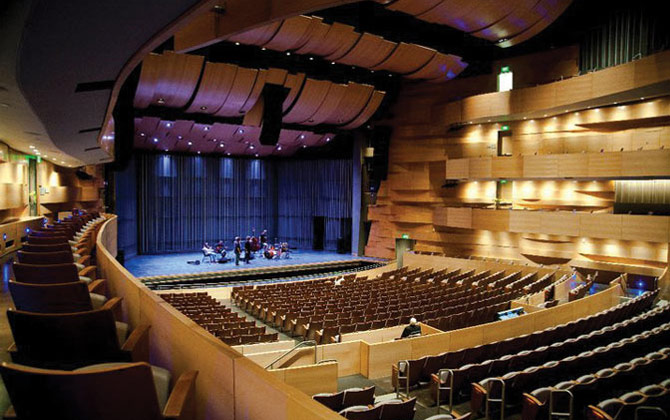
Above: Inside VPAC
But what sets this space apart from comparable spaces is the fact that the system rests solely on a fiber optic infrastructure and utilizes the fiber optic loop on the SD7. “It’s really a change in terms of how much copper wiring you have to run from point A to point B; now we can just run a fiber optic line and a lot of that infrastructure disappears. It’s a big bonus.”
Pro Sound & Video project manager Joe Byrne concurred. “The fact that all mic and line level I/O from the stage panels run back to the DiGiCo racks and is then carried to and from the racks to the control surface over fiber – including preamp control – makes it really an impressive system, as well as being rock-solid and very quiet. The line arrays are being fed with AES digital outputs from the London processing directly to the AES input cards on the Vertec speakers. There is also a redundant copper backup so that even if an AES card goes out on one of the speaker cabinets, the backup system just picks it right up and you don’t lose anything. With the mirrored engines on the SD7, you have yet another redundant backup. So, the PA is a very well designed and fail-safe system that can work for anything from an orchestra to a rock show to a spoken word performance by utilizing the different components in the system. It’s definitely a multi-use place and the fiber optic loop with copper backup is really impressive. Not to mention, the space itself is acoustically designed and well-tuned so that the live PA system and the space work together. They’re not competing and therefore mix engineers don’t have to overcome any anomalies of the room.”
For Byrne, it was his first time out working with DiGiCo. Not only was he impressed with the company customer service at the beginning of the process, but also with the power of the console.
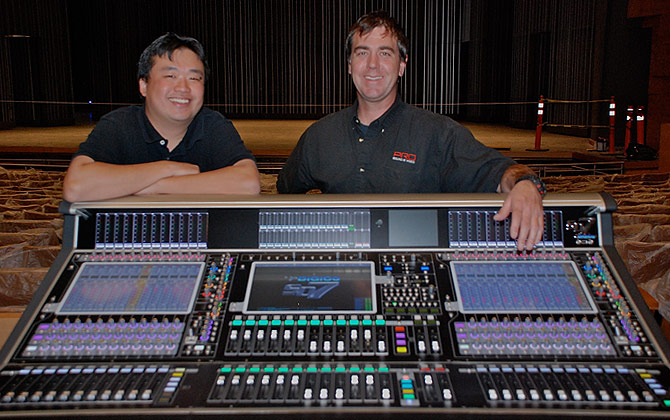
Above: CSUN Audio Supervisor Seiyua Tang (left) and Pro Sound & Video Project Manager Joe Byrne (right).
“The main thing is that the SD7 console/mixing system is so powerful and well designed that there is literally zero outboard processing. There is no outboard dynamic- or time-based processing at the mix position; everything happens from onboard the control surface; impressive. Also, from an integrators perspective, the support we received at the very beginning when there was first mention of a DiGiCo console going in was fantastic. Group One came out to our office and did a demo of the console and spent most of the day going through the features, how it hooks up, operates, etc. Once the system was installed and we had everything programmed, the support from DiGiCo continued with manufacturer training onsite for the operators, although the console itself takes very little training because it’s extremely user-friendly.”
“The first beta show we had was with Doc Severinson and his Ritmo jazz ensemble. They had their studio engineer mixing front of house; he had general experience working on digital consoles in a studio environment but no specific experience on Digico consoles. Once I set up all the routing for him, he was able to immediately start mixing. There was almost a zero learning curve and once he started working on the console he was in his own world and having a blast—that’s what it’s all about. As soon as the house engineer, Seiyua Tang, was on it, he got it too.”
For Tang, the Audio Supervisor at CSUN for the past four years, he was thrilled with the rethought console plan and especially with the selection of the SD7. “The DiGiCo brand is known for exceptional sonic quality and attention to detail and the console keeps us within our mission of being a state-of-the-art facility. Working at Third Encore Rehearsal studios in North Hollywood previously exposed me to the DiGiCo brand. There was a period over a few years where almost every major touring act brought in a D5 Live.”
Looking ahead, Tang says he can foresee many features that will be beneficial to them as they start moving forward with regular programming. “To start with, it features a seemingly limitless amount of input and output channels. This flexibility will allow us to handle any type of performance from lectures to full Broadway productions. The dynamic EQ and multi band compressor is nothing short of genius. With so many engineers out there that know the brand, my job becomes much easier, working with the acts that will be coming through the venue. Most engineers will be up and running in only a few minutes. But the most important feature is that the console sounds as good as it looks!”
